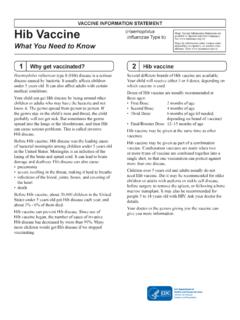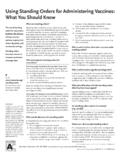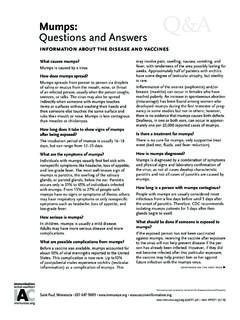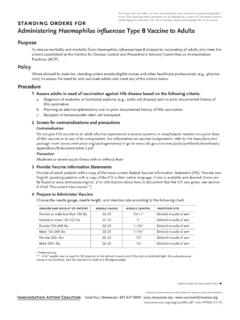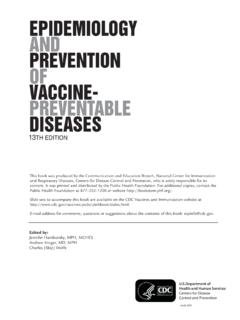Transcription of Photo Collection of Vaccine Preventable-Diseases
1 1 immunization action coalition (651) 647 9009 Item #S8010 (7/16)A Photo Collection of Vaccine preventable DiseasesCreatedbytheCreated by the immunization action CoalitionUpdated July 2016 Diseases for which vaccination is routinely recommended Diphtheria Haemophilus influenzae type b (Hib) Hepatitis A Hepatitis B Mumps Pertussis Pneumococcal disease Polio Herpes zoster (shingles) Human papillomavirus (HPV) Influenza Measles Meningococcal disease Rotavirus Rubella Tetanus Varicella (chickenpox)Diphtheria:This is a picture of the throat of a child who has diphtheria. Notice the thick gray coating over the back of the throat. If not Photo courtesy of the Centers for disease Control and Prevention (CDC)treated, this child could die from :This child has bullneck courtesy of the Centers for disease Control and Prevention (CDC)Haemophilus influenzaetype b:This girl is hospitalized with Haemophilus influenzaetype b (Hib) infection shown here involving deep tissue of this girl s face.
2 Hib disease can also lead to brain damage, seizures, paralysis, hearing loss, and courtesy of the Children s immunization Project, Saint Paul, A:Hepatitis A virus infection has caused this man s skin and the whites of his eyes to turn yellow. Other symptoms of hepatitis A can include loss of appetite, abdominal pain, nausea or vomiting, fever, headaches, and dark urine. Photo courtesy of the Centers for disease Control and Prevention (CDC)2 immunization action coalition (651) 647 9009 Item #S8010 (7/16)Hepatitis B:This woman died from liver cancer four months after she arrived in a refugee resettlement camp. The liver cancer was caused by chronic infection with hepatitis B 2 of 100 adults, 30 of 100 children age 1 5 years, and up to 90 of 100 infants infected with the virus will carry hepatitis B virus in their bodies for life.
3 About 25% will develop serious liver courtesy of Patricia Walker, , Saint Paul, Zoster (shingles):A dangerous complication of shingles infecting the eye which can lead to loss of vision. Without vaccination, approximately 30% of all people who have been infected with chickenpox will later develop shingles. Photo courtesy of Papillomavirus (HPV):HPV is the most common sexually transmitted infection in the United States. Approximately 79 million American are infected with HPV. Most sexually active men and women will get at least one type of HPV at some point in their lives. Photo courtesy of the Centers for disease Control and Prevention (CDC)Persistent infection with high risk types of HPV is associated with almost all cervical cancers. An estimated 29,600 HPV associated cancers occur annually in the cancerHuman Papillomavirus (HPV)Virus like particles assembled from the L1 Protein of Human Papillomavirus 16 Human photos of people with HPV usually include genitalia and are quite graphic, so we have chosen not to include them here.
4 To view some of these photos, go to the Public Health Image Library at type HPV in the search box. You can also use the Google image search feature. Photo courtesy of the Centers for disease Control and Prevention (CDC)Influenza:This Photo shows how the influenza virus can spread through the air when someone coughs. Photo courtesy of the Centers for disease Control and Prevention (CDC)Influenza: Although many people think of influenza as just a common cold, it is really a specific and serious respiratory infection that can result in hospitalization and the , the number of influenza associated deaths has increased since 1990. This increase is due in part to the substantial increase in the number of people age 65 years or older Photo courtesy of the National Museum of Health and Medicine, Armed Forces Institute of Pathologyppgywho are at increased risk for death from influenza CDC study found that more than 200,000 people in the are hospitalized each year for respiratory and heart conditions illnesses associated with seasonal influenza virus action coalition (651) 647 9009 Item #S8010 (7/16)Influenza: Photo of emergency hospital during the 1918 influenza pandemic, Camp Funston, Kansas.
5 This pandemic killed at least 50 million people worldwide. Photo courtesy of the National Museum of Health and Medicine, Armed Forces Institute of PathologyMeasles:This child has a severe measles rash. He has red eyes, a runny nose, and a fever. Measles can cause iibipneumonia, seizures, brain damage, and even death. Death from measles occurs in 2 to 3 per 1,000 reported cases in the courtesy of the Centers for disease Control and Prevention (CDC)Measles:Boy with courtesy of the Centers for disease Control and Prevention (CDC)Meningococcal disease : Meningococcal disease is a sudden life threatening illness. It is caused by bacteria that infect the blood, brain, and spinal cord. People often call it meningitis. Even with proper treatment, 10 15% of people with meningococcal diseasedie.
6 Of the people who survive, as many as 20% suffer from some serious complication, such as loss of an arm or leg, brain damage, or permanent hearing loss. Meningitis can cause shock, coma, and death within hours of the first moving photos and stories of survivors of meningococcal disease , go to and events/protecting our tomorrow portraits of meningococcal diseasePhoto courtesy of the Centers for disease Control and Prevention (CDC)Meningococcal disease : This four month old infant has gangrene of her hands and lower extremities as a result of courtesy of the Centers for disease Control and Prevention (CDC)Mumps:This child s jaw and cheek are swollen from mumps. Mumps can lead to painful swelling of the testicles in males, deafness, and brain courtesy of the Centers for disease Control and Prevention (CDC)4 immunization action coalition (651) 647 9009 Item #S8010 (7/16)Pertussis:This child has pertussis (whooping cough).
7 He has severe coughing spasms, which are often followed by a whooping sound. It is difficult for him to stop coughing and catch his are the most likely to die from pertussis and can have complications such as seizures and brain courtesy of the Centers for disease Control and Prevention (CDC) Photo courtesy of Thomas Schlenker, MD, MPH, Chief Medical Officer, Children's Hospital of WisconsinPertussis: This child has broken blood vessels in his eyes and bruising on his face because of coughing from disease :This is a Photo of the brain of a person who died from pneumococcal meningitis. Note the purulence (pus) that covers the brain surface. Pneumococcal disease is caused by bacteria that can lead to serious infections in the lungs (pneumonia), blood, and brain (meningitis). Photo courtesy of the Centers for disease Control and Prevention (CDC)Polio:This 1952 Photo of a Los Angeles hospital respiratory ward shows polio victims in iron lungs machines which were necessary to help victims courtesy of the Centers for disease Control and Prevention (CDC)Polio:This child has a severely deformed leg caused by polio has been eliminated from mostof the worlduntilpoliovirusworld, until poliovirus transmission is interrupted in every country, all countries remain at risk of importation of courtesy of the World Health Organization (WHO)Rotavirus: Doctor examining a child dehydrated from rotavirus infection.
8 In developing countries, rotavirus causes about half a million deaths each year in children younger than age 5 all unvaccinated children get infected with rotavirus before they are 5 years old. Photo courtesy of World Health Organization, Photo credit Dr. D. Mahalanabis 5 immunization action coalition (651) 647 9009 Item #S8010 (7/16)Rubella:This teenager has a rash from rubella. The rash is not as prominent as the measles rash and is often missed in diagnosis. Rubella in pregnant women can lead to miscarriage, severe heart defects, and blindness or deafness in their courtesy of the Centers for disease Control and Prevention (CDC)Rubella:This infant was born with rubella. Babies whose mothers were infected with rubella during pregnancy can be born with deafness, blindness, heart damage, and intellectual courtesy of the Centers for disease Control and Prevention (CDC)Tetanus:This baby has neonatal tetanus.
9 His body is rigid. Infection can occur when the newly cut umbilical cord is exposed to dirt, as can occur in a developing country. Most newborns who get tetanus die. Neonatal tetanus can be prevented by hygienic delivery practices, and/or by immunizing mothers against courtesy of the Centers for disease Control and Prevention (CDC)Tetanus:This person has tetanus. The muscles in his body are in spasm, making it nearly impossible for him to move. Tetanus bacilli live in the soil, and many types of injuries can allow the bacteria to enter the body. Photo courtesy of the Centers for disease Control and Prevention (CDC)Varicella:This Photo shows the typical itchy chickenpox rash. There can be 500 sores or cases of chickenpox are mild, but deaths from this disease can occur. Before Vaccine became available, about 100 previously healthy people died every year in the from chickenpox.
10 Photo courtesy of the Centers for disease Control and Prevention (CDC)Varicella:This newborn has a secondary bacterial infection, which is a complication following infection with gvaricella (chickenpox). He contracted chickenpox from his infected : Unknown6 immunization action coalition (651) 647 9009 Item #S8010 (7/16)Other diseases for which vaccines are used in special situations Adenovirus Anthrax Cholera Japanese encephalitis Rabies Smallpox Typhoid fever Yellow feverAdenovirus: Adenoviruses are common causes of respiratory illness, but most infections are not severe. They can cause cold like symptoms, sore throatbronchitisthroat, bronchitis, pneumonia, diarrhea, and pink eye (conjunctivitis). Photo courtesy of the Centers for disease Control and Prevention (CDC)A Vaccine against adenovirus types 4 and 7 is approved by FDA for military personnel : Anthrax is a serious disease caused by Bacillus anthracis, a bacterium that forms spores.

